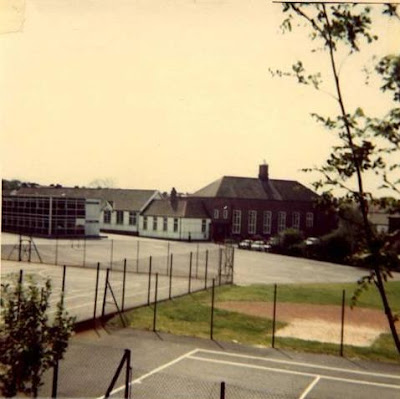Now I am pretty pleased with the Glad to be in Chorlton History Trails and I doubt that there are many other places where you can read about the history of a locality by visiting a succession of local pubs and shops.
The trails began three years ago with a series of story panels in the Horse and Jockey, Fanny and Filer on Beech Road and the Bar and tell the story of how Chorlton developed from a small rural community into a vibrant part of south Manchester.
And now can also be seen at Chorlton Eatery, Fosters Cycles, and Morrisons.
The project culminated with an 80 meter installation on Albany and Brantingham Roads which was designed to take you on a walk from Chorlton Green in the 16th century across Chorlton in both time and apace ending in the 21st century close to the new Metro line.
The 16 giant panels remained on site for almost a year before moving to their permanent home at Chorlton High School.
And across the township there are smaller additions to the trail. Each consists of an original painting by Peter Topping; some period photographs with a little bit of Chorlton’s history and included in the story is something unique to the building where the panel is on display.
So in the case of Franny and Filer the trail offers up a description of Beech Road in the 19th century and in particular the history of the building which for over 70 years was a beer shop.
And I can now announce that the latest addition to the trail is at the Phoenix Deli on Oswald Road.
The shop has seen many businesses since it first opened in 1907 and I like the idea that just 108 years after it started up as a bakery selling fine bread and cakes it is again serving a mix of cakes sandwiches and much more.
Not that I am going to say anymore, for the history of the place and of this bit of Oswald Road you will just have go down there and read it for yourself.
Pictures; the history trail at the Phoenix Deli, text and research by Andrew Simpson, painting and design and layout by Peter Topping
*Glad to be in Chorlton, http://chorltonhistory.blogspot.co.uk/search/label/Glad%20to%20be%20in%20Chorlton
The Phoenix Deli, 127 Oswald Road, Manchester M21 9GE, 0161 222 4990
e: :info@thephoenixdeli.co.uk
w: www.thephoenixdeli.co.uk
Opening times Monday-Friday 7.30 - 3 pm Saturday 8.30 - 2.30 pm
Painting; the Phoenix Deli © 2015 Peter Topping
Web: www.paintingsfrompictures.co.uk
Facebook: Paintings from Pictures https://www.facebook.com/paintingsfrompictures
 |
| Learning a little bit of Oswald Road's history, 2015 |
And now can also be seen at Chorlton Eatery, Fosters Cycles, and Morrisons.
The project culminated with an 80 meter installation on Albany and Brantingham Roads which was designed to take you on a walk from Chorlton Green in the 16th century across Chorlton in both time and apace ending in the 21st century close to the new Metro line.
 |
| Inside the Phoenix Deli, 2015 |
And across the township there are smaller additions to the trail. Each consists of an original painting by Peter Topping; some period photographs with a little bit of Chorlton’s history and included in the story is something unique to the building where the panel is on display.
So in the case of Franny and Filer the trail offers up a description of Beech Road in the 19th century and in particular the history of the building which for over 70 years was a beer shop.
And I can now announce that the latest addition to the trail is at the Phoenix Deli on Oswald Road.
 |
| Outside the Deli looking in, 2015 |
Not that I am going to say anymore, for the history of the place and of this bit of Oswald Road you will just have go down there and read it for yourself.
Pictures; the history trail at the Phoenix Deli, text and research by Andrew Simpson, painting and design and layout by Peter Topping
*Glad to be in Chorlton, http://chorltonhistory.blogspot.co.uk/search/label/Glad%20to%20be%20in%20Chorlton
The Phoenix Deli, 127 Oswald Road, Manchester M21 9GE, 0161 222 4990
e: :info@thephoenixdeli.co.uk
w: www.thephoenixdeli.co.uk
Opening times Monday-Friday 7.30 - 3 pm Saturday 8.30 - 2.30 pm
Painting; the Phoenix Deli © 2015 Peter Topping
Web: www.paintingsfrompictures.co.uk
Facebook: Paintings from Pictures https://www.facebook.com/paintingsfrompictures














































